

Page 54
Ireland ![]()
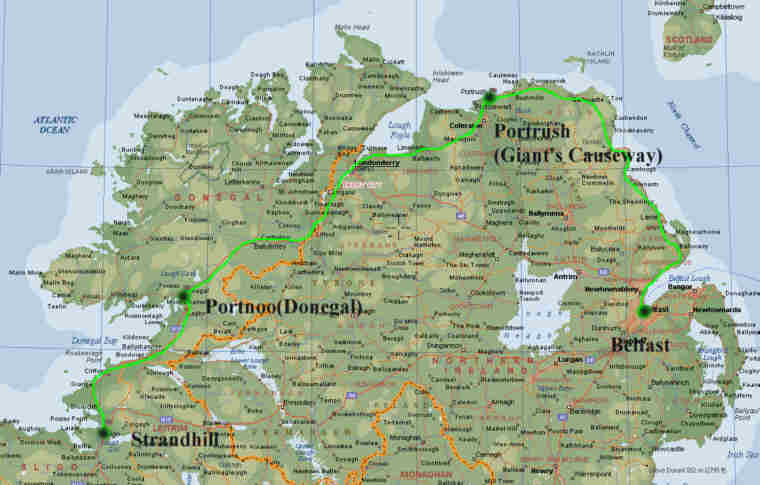
DAY
183
Strandhill
to Portnoo (Donegal)
To my great surprise and delight it wasn’t raining in the morning and the strong wind had completely dried our tents. Our luck was holding for the fourth day.
Breakfast was fast and delicious; the Irish seem to know what we like and they are well prepared with a lot of it. There was muesli and other cereals, eggs and bacon, hotcakes, bananas, apples, oranges and melon slices. My pancakes were cold and there was no syrup so I ate them with orange marmalade and they were delicious that way. I have noticed that in the bread section of food stores there are bags of cooked pancakes for sale. What a convenience!
I made it my mission for the day to find a telephone where I could successfully send e-mail. The hunt was on! I stopped over and over, trying each phone with no success. I could connect with AT&T and Pocketmail, but after a few seconds the transmission would fail. Frustrating! Time consuming! Expensive! Finally though in a food shop I found a phone that worked on the second attempt. Yeah!
We rode through beautiful countryside; rolling green hills and steeper hills, boundaries marked with hedgerows or stone fences, the sheep and cattle grazing or chewing their cuds. The farmers were busy making hay. Bigger farms have big fast tractors and special equipment to turn the hay and later to roll it into large bundles covered with black plastic. We came upon a very old and beautiful stone church, built in the 14th century and long since abandoned. There were some tricky bits on the DRG and one of them was at 65.8 miles. It read: ‘LEFT onto small road at blue house tucked away in trees. Then CROSS a small river.’ As it turned out, that blue house was up a hill and nearly hidden by the trees, nothing you could have seen while cycling. But Ben was looking out for me. He knew I was behind him so he stopped at the turn to wait for me. He had stopped there because Dickie had stopped there before him, wondering if that blue house could be THE blue house. Just about then Allison came riding back having cycled right past the blue house for a mile or so. It was fortunate that the DRG had given the second hint, ‘Then CROSS a small river.’ We get lots of odd or obscure directions on our DRG’s. Yesterday we were to turn three different times at ‘the white house on the corner’. Half the houses in Ireland are white!
Our campground was not the one on the DRG, which as it turned out did not allow tents. Unfortunately where we did camp we were four miles from the Narin Inn where we were to have our meals. To solve the problem TK&A rented two mid-size busses to shuttle us back and forth. The whole dinner experience took the entire evening, all of our free time was lost. The drive, though only four miles, was slow going because the busses were too big for the narrow roads causing a delay when we met oncoming traffic. But the real problem was the wait at the restaurant. I was in the 8:00 group, having cycled in too late to make the first seating at 6:30. We had to wait outside with the no-see-ums biting us until the staff and food were ready. After dinner we had an interminable wait, outside again, for a return ride. It was windy and cold and the no-see-ums had been flying in wait for us.
Late in the evening Young Dave of Wisconsin fell while playing on a huge, steep sand dune. He was running and jumping, having a great time when things went wrong and he somersaulted, landing hard. He scared everyone by becoming dizzy and shivering with cold. His arm was hurting so Karen Ann took him to the closest hospital for an x-ray. He is lucky, no broken bones!
Goodbye,
Alice
DAY
184
Portnoo
to Portrush (Giant's Causeway)
When I unzipped my tent in the morning two things were obvious, the no-see-ums had lain in wait and the sun was shining. The second I unzipped my tent and stepped out I was in a swarm of no-see-ums. We batted in vain at those pesky insects while taking down our tents and storing our gear. I willed myself to ignore them but I couldn’t. C.J., who wore a mesh bag over her head and neck, was the envy of everyone.
We had to bicycle four miles back to the Narin Inn for breakfast which had seemed like an awful idea the night before when we were so tired from that day’s ride, but in fact the countryside was beautiful and the ride was not entirely uphill, there were some fun downs. We had the typical British breakfast: fried eggs, bacon, sausage, baked beans, grilled tomato halves, fried potato bread and fried ordinary bread. A very greasy meal! There was orange juice but no other fruit and no yogurt. However we could choose to have oatmeal or cold cereal so there was a healthy option. One thing that is good about the English breakfast is that it does ‘stick to your ribs’ making it possible to pedal further before stopping to eat.
The road was extremely rough, my hands taking the worst of the beating with little blisters forming on the outside of each index finger where they came in contact with the handlebars. I couldn’t hold the handlebars in a more relaxed manner because of the poor road conditions and my gloves were too worn to provide much protection. I resolved to break out my new pair of gloves for the next day’s ride. We rode through the Glendowan National Park which is a large area, high, green, rocky, and populated only by sheep. There are no trees but there are brooks and marshy areas. The sheep aren’t fenced and seem used to traffic, not even bothering to raise their heads from their grazing when we passed.
By the time I reached Checkpoint I had had enough of the rough Irish roads and put myself on the sag list. As it turned out, that was a good move, for the rest of the route was repetitious, unattractive, and still hilly. One city on the route was Londonderry which proved to be unfortunate for 3 riders, Big Eric, Michel Kahn, and Ken Anderson. They parked and locked their bikes and then went to lunch. When they came back their bicycles were gone, only the cut chains remained. That makes 9 bikes stolen to date I think, and poor Ken has lost two of them. The first was his Odyssey bike which was stolen in South Africa, the second was his bike from home. Not only are the bikes lost but everything on them. Most of us have hundreds of dollars in special equipment, gadgets, bags, cameras, and clothing on our bikes. These 3 men are big and have had to put extra strong wheels on their bikes to prevent the spokes from breaking. They alone cost hundreds of dollars. Then there is the problem of replacing the bikes. It takes time to find suitable bikes and equipment, not to mention the expense. The only defense we have against bicycle thieves is to never leave our bikes unguarded which can really limit the options for rest stops or meals. I think Elbert, who sleeps with his bike in his tent, has the right idea. And I am wondering whether there is a noisy alarm that can be attached to the bike and set to go off if the bike is moved. If there is, I want one.
Goodbye, Alice
DAY
185
Portrush
to Belfast
It didn’t rain but our tents were sopping wet in the morning anyway. The sun was coming up and would have dried them but we had no time to wait for that, rushing to get everything done and get to breakfast as early as possible. We had an 85 mile day ahead of us, the fifth long day in a row. We were foiled though, for whatever reason breakfast was moved from 6:30 to 7:00, so many of us had to wait for 30 minutes or more for the DRG's which are not made available until 15 minutes before breakfast. Once they are put out the race is on. Some riders are always in a rush and are driven by some need to be out of camp as early as possible. There is a sort of unofficial race going on among these men (mostly) and each wants to come into camp before the others. The first to camp everyday without exception is Trueheart. There are some, like Racer Bob, who would give their eyeteeth to beat him, but I think it won’t happen unless Trueheart’s bike falls apart. Trueheart always gets out of camp very early but doesn’t make a fuss about it. When the DRG's come out he doesn’t grab them and run, but very carefully folds each page in an origami sort of way to make it smaller and easier to read on the fly. At his speed he could never read a paper that was flapping in the wind!
The first half of this ride was absolutely stunning! There were so many things to stop to see, so many pictures to take, so many hills to climb, that this is another day that would have been better halved. Our camp was on the coast and our ride for much of the day followed the rugged, beautiful coast. It was very hilly and there was a strong headwind, so strong that I could go at only about half of my already tortoise-like pace. But it didn’t matter. The scenery and the sunshine made the effort worthwhile.
Some people stopped only 5 miles out of camp at the first distraction of the day, the Bushmill’s Distillery. I had never heard of the Bushmill’s Distillery so I was not tempted to stop there, but according to the DRG it is the oldest licensed whiskey distillery in the world, for whatever that is worth.
The Giant’s Causeway though did catch my attention. What an incredible sight! There is a legend that says that the giant Fin McCoul put the stones there to use as a bridge or causeway so that a Scottish giant could come to Ireland for a contest of strength, but in actual fact they are the result of a volcano. Some 60 million years ago, the lava flowed out of cracks in the earth rather than from a volcanic cone. When the lava cooled it solidified into layers of hard basalt. As the layers contracted, they formed masses of adjoining columns, which tower high into the air. Each column split into separate stones, so that a single column looks like a very high stack of stepping-stones. Most are hexagons, but there are some with four, five, seven, and eight sides. I will have to talk to a geologist about this amazing phenomenon some day. One rider told me that there is a similar formation in California. I was not aware of that.
The next best part of the day was a super, really super, downhill that ended at the Glendun Viaduct on the way to Cushendall. It was only 2 miles long but it was gorgeous! Great scenery, good road, and only one or two hairpin curves. It took a lot of climbing to get there but the fantastic descent made me forget the hard painful work.
Our destination for the day was Belfast; scary, battling Belfast. We were assigned rooms in new dorms at The Queens University of Belfast about two miles from the center of town. Everyone scurried to get their chores done: drying tents in the windy sunshine, doing laundry by hand or machine and hanging it everywhere to dry. It wasn’t long before we had transformed the appearance of the residence halls what with tents flapping out the windows and laundry drying on the bike racks. Odyssey 2000 had come to town.
Goodbye,
Alice
DAY
186
Belfast
Layover Day
The thing-to-do in Belfast was the Black Taxi Mural Tour. We had made reservations the night before and gathered with a couple dozen other riders to wait in the bright morning sunshine for the taxis to arrive. This was our seventh day in Ireland and the sunniest day yet. We were delighted while the Irish themselves were astounded. Eventually several of the black London style taxis arrived. We were assigned to Jeff who would be our driver and guide. Going with me were Judy B., Brenda, Dot, and Linda. At the last moment Matt of Antarctica showed up and came with us as we had a seat to spare.
Jeff drove first to the Shankill Road area and a nearby Protestant neighborhood. He was talking all the while but I could understand only a little of what he said because of his accent. When we arrived at the first set of murals we stopped for a closer look and listened intently while Jeff tried to explain the meaning or significance of each of the huge and colorful murals. Some promote the goal of the Protestants, which is to remain a part of the United Kingdom while others commemorate fallen heroes. Mural painters are hired at the rate of 100 pounds per mural and every poster in the Protestant neighborhood looked newly done, no doubt in preparation for the march and celebration on July 11 and 12. The posters are painted on the end walls of two story apartment buildings, which are called council blocks, low cost housing provided by the government.
Poor Jeff! We asked for clarification over and over but he never lost patience with us. In my opinion this conflict is hard to understand in the first place and there are too many groups and unfamiliar initials for the various factions, plus the problem of trying to make out what he was saying with his Irish accent.
The entire neighborhood was decorated with strings of red, white and blue flags making it look very festive. But spoiling the party-like atmosphere were the piles of trash. There was a vast green field across the street from the apartments with their bright murals and flags, and strewn and piled over this area were mountains of things that would burn. There were hundreds or thousands of wooden pallets, tires, and pieces of furniture. It was a dreadful eyesore and must have been collecting for months. It was hard for me to comprehend that grown men would set fire to all that rubbish and think it a clever thing to do.
Then we drove to the Catholic area, passing through a high steel gate that can be closed if needed to stop traffic between the neighborhoods. Again we looked at murals, these were promoting the idea of a separate country to be called Ulster, and also commemorating fallen heroes and martyrs. Again there were many factions and confusing initials to try to sort out. It seems that these politically active people are not only in conflict with the opposite side, the Catholics against the Protestants and vice a versa, but also compete within their own side. ‘Too many chiefs’, I said.
As we rode through the Catholic area Jeff pointed out locations where bombings and other incidents had occurred. He showed us where the fishmongers shop had been. It had been blown up, killing the owner and his family and the bomber as well which was not supposed to happen. The usual procedure is to plant the bomb and leave, go a safe distance away, then call the people where the bomb is planted and warn them to get out. But this time something went amiss with the bomb and it blew up too soon, killing the bomber before he could get away.
We drove to a very high concrete and steel wall that separates the Catholic part of town from the Protestant. The houses on the Protestant side have been repaired or replaced but those on the Catholic side still bear the evidence of the paint bombs that were thrown at them before the peace agreement. This separating wall, reminiscent of the Berlin wall, has graffiti all over it, largely done by tourists who are brought there by the Black Taxi drivers and given markers so that they can express their opinions about the conflict.
As we drove past the enormous city cemetery Jeff told us about another wall that can’t be seen. Protestants and Catholics are buried in the cemetery in their separate sections. To keep them separate, a 12-foot high wall has been built underground. The cemetery is situated on a hillside. Jeff said that over time the coffins gradually slide down the slope making it possible that the two factions could become mixed. The wall is to keep them separated. I thought, “Now I have heard everything!”
Finally our two-hour tour was coming to an end. I was still confused but a little closer to knowing what the two sides in the struggle want at least. These two sides, the Protestant and the Catholic would seem to be divided by their religions since they are identified by religion, but apparently a conflict about religious beliefs does not enter into it. If you are born a Protestant then you believe in remaining a part of the United Kingdom. If you are born a Catholic then you believe in a separate state to be called Ulster. It looks like an unsolvable problem, but the man in the street is fed up with the conflict and wants only peace. Jeff doesn’t think he’ll see that in his lifetime, unlike our professor in Dublin who was so positive about a solution sooner rather than later.
The tour over Jeff dropped us at his favorite cafe in downtown Belfast where we had some pretty awful food. We could forgive him that though because he offered to pick us up after lunch and cart us back to our dorms at the University. He was going that way anyway to collect his passengers for another tour.
I spent the afternoon walking to the post office and working on the web page. After dinner Tim of TK&A held a meeting to brief us on changes he had made in our itinerary and to give us directions for the ferry to Scotland in the morning. As it turned out, no one really liked the changes he had made and many said so. One change was to eliminate Japan altogether. I had thought all along that this could happen once he realized how expensive it is for Americans to travel in Japan. He has promised to review and revise. We’ll see.
Goodbye, Alice
Ireland
![]()
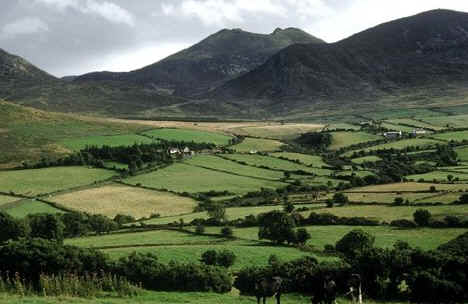
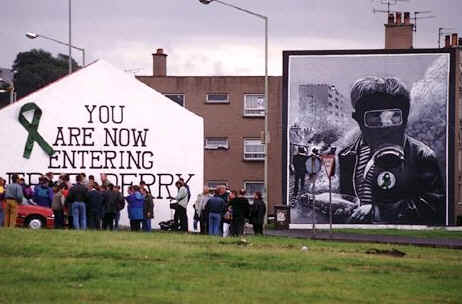
Political Graffiti in Northern Ireland (Right)
Established in the 6th century, Londonderry, Northern Ireland’s second largest city, was formerly called Derry. In 1613 jurisdiction of the town was granted to the city of London to colonize, and it became known as Londonderry. Political graffiti on the city’s walls highlights the historic struggle between nationalists, who want a united Ireland (and who, like the city council, still call the city Derry), and unionists, who want Northern Ireland to remain part of the United Kingdom. In April 1998 peace talks sponsored by the British and Irish governments culminated in a long-awaited agreement, raising hopes for a resolution to the decades-old conflict. The settlement was put to a referendum in Northern Ireland and Ireland , and it was approved by an overwhelming majority of voters.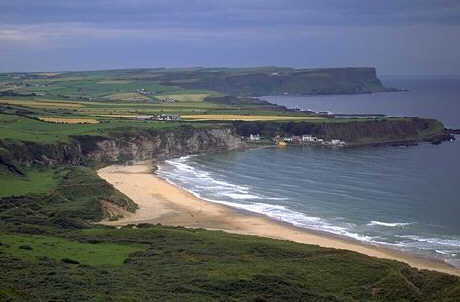
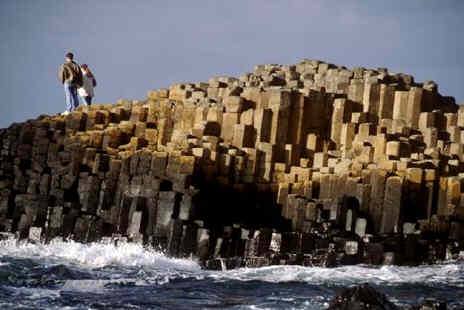
Rolling Surf on the Antrim Coast (Left)
The Antrim coast, noted for its rugged beauty, reaches out toward Scotland—only 21 kilometers (13 miles) away across the The Deeps. A scenic road hugs much of this stretch of coastline. Starting at Larne, a seaside resort and ferry terminus for crossings to Scotland, the coast road provides access to many of the county’s main attractions, including Giant’s Causeway. Inland, the topography is dominated by the Antrim Mountains and their remarkably beautiful glens.Giant’s Causeway (Right)
The Giant’s Causeway, on the coast of County Antrim, is one of Northern Ireland's most famous tourist attractions. Ancient lava flows left a rock formation with thousands of regularly shaped basalt columns rising to more than 6 meters (more than 20 feet). An old myth says that the legendary Irish hero Fionn mac Cumhaill (Finn MacCool) was a giant who used the formations as stepping stones.
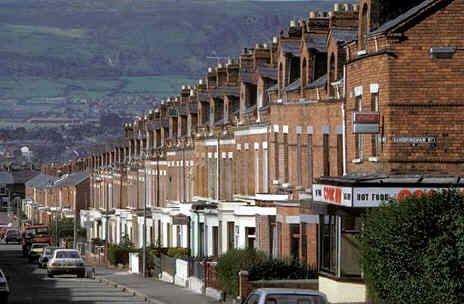

Children at an Orange March (Right)
Every July thousands of Protestant Ulstermen march through the streets of Belfast to commemorate the Protestant victory at the Battle of the Boyne in 1690. The battle ended the attempt by Charles II, a Roman Catholic, to regain the English throne after he lost it to the Protestant William of Orange during the Glorious Revolution. The victory began centuries of Protestant domination. In recent years the Orange marches, traditionally seen by Catholics as symbols of Protestant oppression, have often been the focus of sectarian violence in the province. In July 1996 police in Portadown, a town about 37 kilometers (about 23 miles) outside of Belfast, ordered the annual march to be rerouted to avoid a Catholic neighborhood. After three days of fiery riots, the decision was reversed. Police escorted the Unionist marchers along their traditional route amidst chaotic Catholic protests.

Odyssey Riders and Staff


Today's Music
When Irish Eyes are Smiling